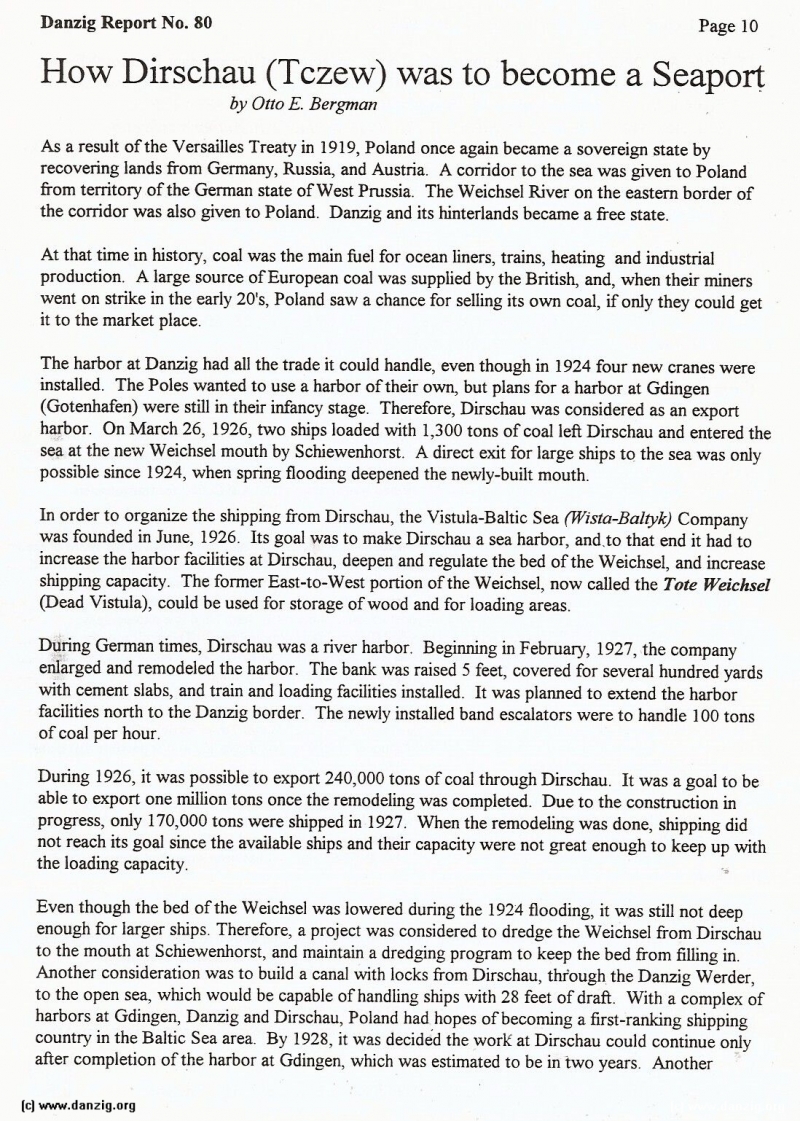
How Dirschau (Tczew) was to become a Seaport
by Otto E. Bergman
As a result of the Versailles Treaty in 1919, Poland once again became a sovereign state by recovering lands from Germany, Russia, and Austria. A corridor to the sea was given to Poland from territory of the German state of West Prussia. The Weichsel River on the eastern border of the corridor was also given to Poland. Danzig and its hinterlands became a free state.
At that time in history, coal was the main fuel for ocean liners, trains, heating and industrial production. A large source of European coal was supplied by the British, and, when their miners went on strike in the early 20s, Poland saw a chance for selling its own coal, if only they could get it to the market place.
The harbor at Danzig had all the trade it could handle, even though in 1924 four new cranes were installed. The Poles wanted to use a harbor of their own, but plans for a harbor at Gdingen (Gotenhafen) were still in their infancy stage. Therefore, Dirschau was considered as an export harbor. On March 26, 1926, two ships loaded with 1,300 tons of coal left Dirschau and entered the sea at the new Weichsel mouth by Schiewenhorst. A direct exit for large ships to the sea was only possible since 1924, when spring flooding deepened the newly-built mouth.
In order to organize the shipping from Dirschau, the Vistula-Bahic Sea (Wista-Ballyk) Company was founded in June, 1926. Its goal was to make Dirschau a sea harbor, and.to that end it had to increase the harbor facilities at Dirschau, deepen and regulate the bed of the Weichsel, and increase shipping capacity. The former East-to-West portion of the Weichsel, now called the Tote Weichsel (Dead Vistula), could be used for storage of wood and for loading areas.
During German times, Dirschau was a river harbor. Beginning in February, 1927, the company enlarged and remodeled the harbor. The bank was raised 5 feet, covered for several hundred yards with cement slabs, and train and loading facilities installed. It was planned to extend the harbor facilities north to the Danzig border. The newly installed band escalators were to handle 100 tons of coal per hour.
During 1926, it was possible to export 240,000 tons of coal through Dirschau. It was a goal to be able to export one million tons once the remodeling was completed. Due to the construction in progress, only 170,000 tons were shipped in 1927. When the remodeling was done, shipping did not reach its goal since the available ships and their capacity were not great enough to keep up with the loading capacity.
Even though the bed of the Weichsel was lowered during the 1924 flooding, it was still not deep enough for larger ships. Therefore, a project was considered to dredge the Weichsel from Dirschau to the mouth at Schiewenhorst, and maintain a dredging program to keep the bed from filling in. Another consideration was to build a canal with locks from Dirschau, through the Danzig Werder, to the open sea, which would be capable of handling ships with 28 feet of draft. With a complex of harbors at Gdingen, Danzig and Dirschau, Poland had hopes of becoming a first-ranking shipping country in the Baltic Sea area. By 1928, it was decided the work at Dirschau could continue only after completion of the harbor at Gdingen, which was estimated to be in two years. Another
Danzig Report Vol. 1 - Nr. 80 - July - August - September - 1993, Page 11.
Hits: 1659
Added: 05/07/2015
Copyright: 2024 Danzig.org

